Entrepreneurship Report: Exploring Ventures, Impact, and Traits
VerifiedAdded on 2020/01/16
|21
|6667
|255
Report
AI Summary
This report delves into the multifaceted world of entrepreneurship, examining various types of entrepreneurial ventures, including small businesses, scalable start-ups, large company ventures, and social ventures. It explores the similarities and differences between entrepreneurial ventures, highlighting the roles of serial entrepreneurs, intrapreneurs, and owner-managers. The report assesses the impact of micro and small businesses on the economy, analyzing relevant data and statistics. Furthermore, it investigates the characteristics, traits, and skills of successful entrepreneurs, exploring how background and experience can influence entrepreneurial outcomes. The analysis includes a critical examination of the scope, development, and growth of entrepreneurial ventures in both the public and corporate sectors. The report concludes by emphasizing the importance of entrepreneurship in driving economic growth and innovation.

ENTREPRENURSHIP
Paraphrase This Document
Need a fresh take? Get an instant paraphrase of this document with our AI Paraphraser
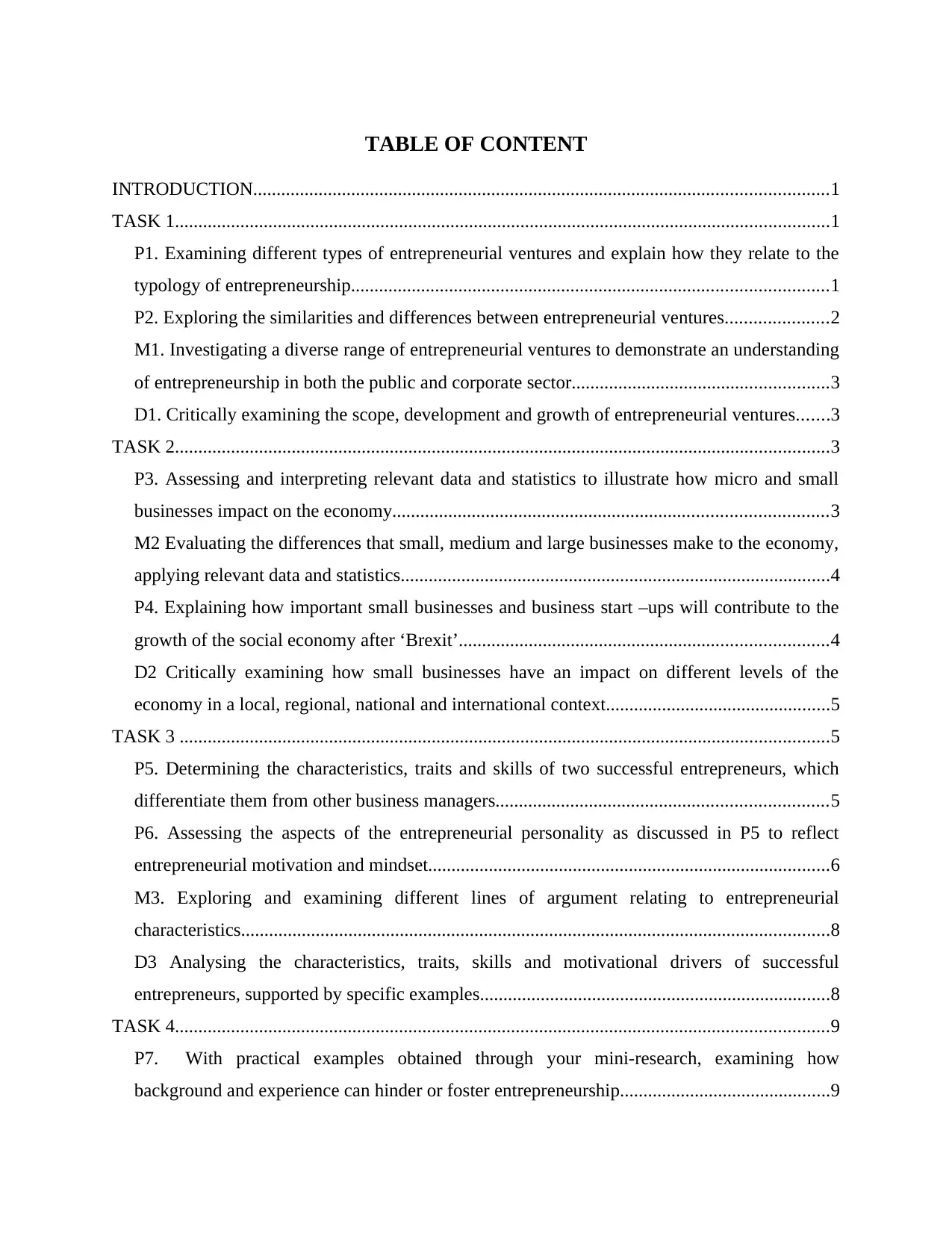
TABLE OF CONTENT
INTRODUCTION...........................................................................................................................1
TASK 1............................................................................................................................................1
P1. Examining different types of entrepreneurial ventures and explain how they relate to the
typology of entrepreneurship......................................................................................................1
P2. Exploring the similarities and differences between entrepreneurial ventures......................2
M1. Investigating a diverse range of entrepreneurial ventures to demonstrate an understanding
of entrepreneurship in both the public and corporate sector.......................................................3
D1. Critically examining the scope, development and growth of entrepreneurial ventures.......3
TASK 2............................................................................................................................................3
P3. Assessing and interpreting relevant data and statistics to illustrate how micro and small
businesses impact on the economy.............................................................................................3
M2 Evaluating the differences that small, medium and large businesses make to the economy,
applying relevant data and statistics............................................................................................4
P4. Explaining how important small businesses and business start –ups will contribute to the
growth of the social economy after ‘Brexit’...............................................................................4
D2 Critically examining how small businesses have an impact on different levels of the
economy in a local, regional, national and international context................................................5
TASK 3 ...........................................................................................................................................5
P5. Determining the characteristics, traits and skills of two successful entrepreneurs, which
differentiate them from other business managers.......................................................................5
P6. Assessing the aspects of the entrepreneurial personality as discussed in P5 to reflect
entrepreneurial motivation and mindset......................................................................................6
M3. Exploring and examining different lines of argument relating to entrepreneurial
characteristics..............................................................................................................................8
D3 Analysing the characteristics, traits, skills and motivational drivers of successful
entrepreneurs, supported by specific examples...........................................................................8
TASK 4............................................................................................................................................9
P7. With practical examples obtained through your mini-research, examining how
background and experience can hinder or foster entrepreneurship.............................................9
INTRODUCTION...........................................................................................................................1
TASK 1............................................................................................................................................1
P1. Examining different types of entrepreneurial ventures and explain how they relate to the
typology of entrepreneurship......................................................................................................1
P2. Exploring the similarities and differences between entrepreneurial ventures......................2
M1. Investigating a diverse range of entrepreneurial ventures to demonstrate an understanding
of entrepreneurship in both the public and corporate sector.......................................................3
D1. Critically examining the scope, development and growth of entrepreneurial ventures.......3
TASK 2............................................................................................................................................3
P3. Assessing and interpreting relevant data and statistics to illustrate how micro and small
businesses impact on the economy.............................................................................................3
M2 Evaluating the differences that small, medium and large businesses make to the economy,
applying relevant data and statistics............................................................................................4
P4. Explaining how important small businesses and business start –ups will contribute to the
growth of the social economy after ‘Brexit’...............................................................................4
D2 Critically examining how small businesses have an impact on different levels of the
economy in a local, regional, national and international context................................................5
TASK 3 ...........................................................................................................................................5
P5. Determining the characteristics, traits and skills of two successful entrepreneurs, which
differentiate them from other business managers.......................................................................5
P6. Assessing the aspects of the entrepreneurial personality as discussed in P5 to reflect
entrepreneurial motivation and mindset......................................................................................6
M3. Exploring and examining different lines of argument relating to entrepreneurial
characteristics..............................................................................................................................8
D3 Analysing the characteristics, traits, skills and motivational drivers of successful
entrepreneurs, supported by specific examples...........................................................................8
TASK 4............................................................................................................................................9
P7. With practical examples obtained through your mini-research, examining how
background and experience can hinder or foster entrepreneurship.............................................9

M4 Linking the entrepreneurial characteristics and the influence of personal background and
experience to specific successful entrepreneurs..........................................................................9
D4 Critically evaluating the way in which background and experience influences
entrepreneurs, both positively and negatively, by comparing and contrasting examples.........10
CONCLUSION..............................................................................................................................10
REFERENCES..............................................................................................................................11
experience to specific successful entrepreneurs..........................................................................9
D4 Critically evaluating the way in which background and experience influences
entrepreneurs, both positively and negatively, by comparing and contrasting examples.........10
CONCLUSION..............................................................................................................................10
REFERENCES..............................................................................................................................11
⊘ This is a preview!⊘
Do you want full access?
Subscribe today to unlock all pages.

Trusted by 1+ million students worldwide

Paraphrase This Document
Need a fresh take? Get an instant paraphrase of this document with our AI Paraphraser
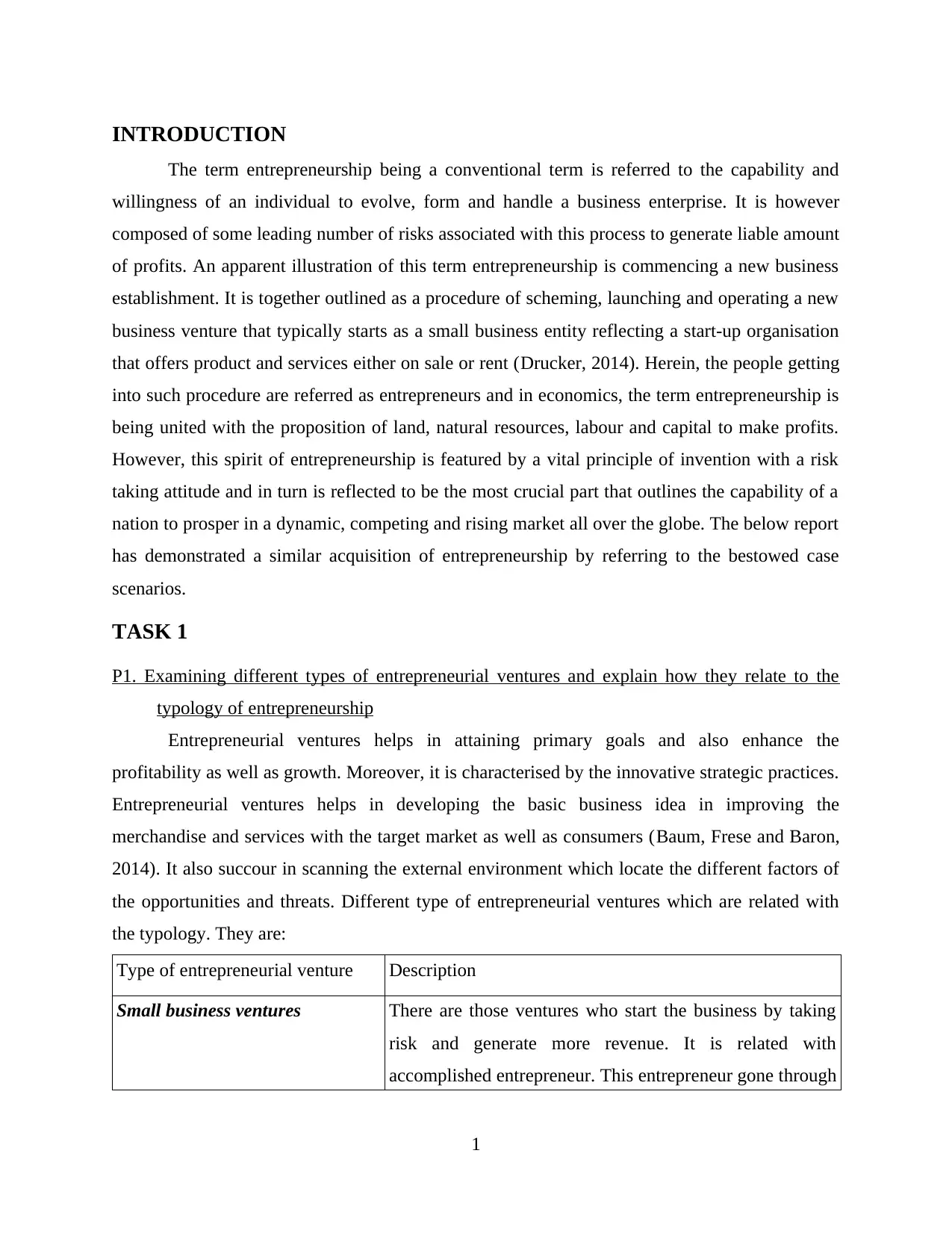
INTRODUCTION
The term entrepreneurship being a conventional term is referred to the capability and
willingness of an individual to evolve, form and handle a business enterprise. It is however
composed of some leading number of risks associated with this process to generate liable amount
of profits. An apparent illustration of this term entrepreneurship is commencing a new business
establishment. It is together outlined as a procedure of scheming, launching and operating a new
business venture that typically starts as a small business entity reflecting a start-up organisation
that offers product and services either on sale or rent (Drucker, 2014). Herein, the people getting
into such procedure are referred as entrepreneurs and in economics, the term entrepreneurship is
being united with the proposition of land, natural resources, labour and capital to make profits.
However, this spirit of entrepreneurship is featured by a vital principle of invention with a risk
taking attitude and in turn is reflected to be the most crucial part that outlines the capability of a
nation to prosper in a dynamic, competing and rising market all over the globe. The below report
has demonstrated a similar acquisition of entrepreneurship by referring to the bestowed case
scenarios.
TASK 1
P1. Examining different types of entrepreneurial ventures and explain how they relate to the
typology of entrepreneurship
Entrepreneurial ventures helps in attaining primary goals and also enhance the
profitability as well as growth. Moreover, it is characterised by the innovative strategic practices.
Entrepreneurial ventures helps in developing the basic business idea in improving the
merchandise and services with the target market as well as consumers (Baum, Frese and Baron,
2014). It also succour in scanning the external environment which locate the different factors of
the opportunities and threats. Different type of entrepreneurial ventures which are related with
the typology. They are:
Type of entrepreneurial venture Description
Small business ventures There are those ventures who start the business by taking
risk and generate more revenue. It is related with
accomplished entrepreneur. This entrepreneur gone through
1
The term entrepreneurship being a conventional term is referred to the capability and
willingness of an individual to evolve, form and handle a business enterprise. It is however
composed of some leading number of risks associated with this process to generate liable amount
of profits. An apparent illustration of this term entrepreneurship is commencing a new business
establishment. It is together outlined as a procedure of scheming, launching and operating a new
business venture that typically starts as a small business entity reflecting a start-up organisation
that offers product and services either on sale or rent (Drucker, 2014). Herein, the people getting
into such procedure are referred as entrepreneurs and in economics, the term entrepreneurship is
being united with the proposition of land, natural resources, labour and capital to make profits.
However, this spirit of entrepreneurship is featured by a vital principle of invention with a risk
taking attitude and in turn is reflected to be the most crucial part that outlines the capability of a
nation to prosper in a dynamic, competing and rising market all over the globe. The below report
has demonstrated a similar acquisition of entrepreneurship by referring to the bestowed case
scenarios.
TASK 1
P1. Examining different types of entrepreneurial ventures and explain how they relate to the
typology of entrepreneurship
Entrepreneurial ventures helps in attaining primary goals and also enhance the
profitability as well as growth. Moreover, it is characterised by the innovative strategic practices.
Entrepreneurial ventures helps in developing the basic business idea in improving the
merchandise and services with the target market as well as consumers (Baum, Frese and Baron,
2014). It also succour in scanning the external environment which locate the different factors of
the opportunities and threats. Different type of entrepreneurial ventures which are related with
the typology. They are:
Type of entrepreneurial venture Description
Small business ventures There are those ventures who start the business by taking
risk and generate more revenue. It is related with
accomplished entrepreneur. This entrepreneur gone through
1
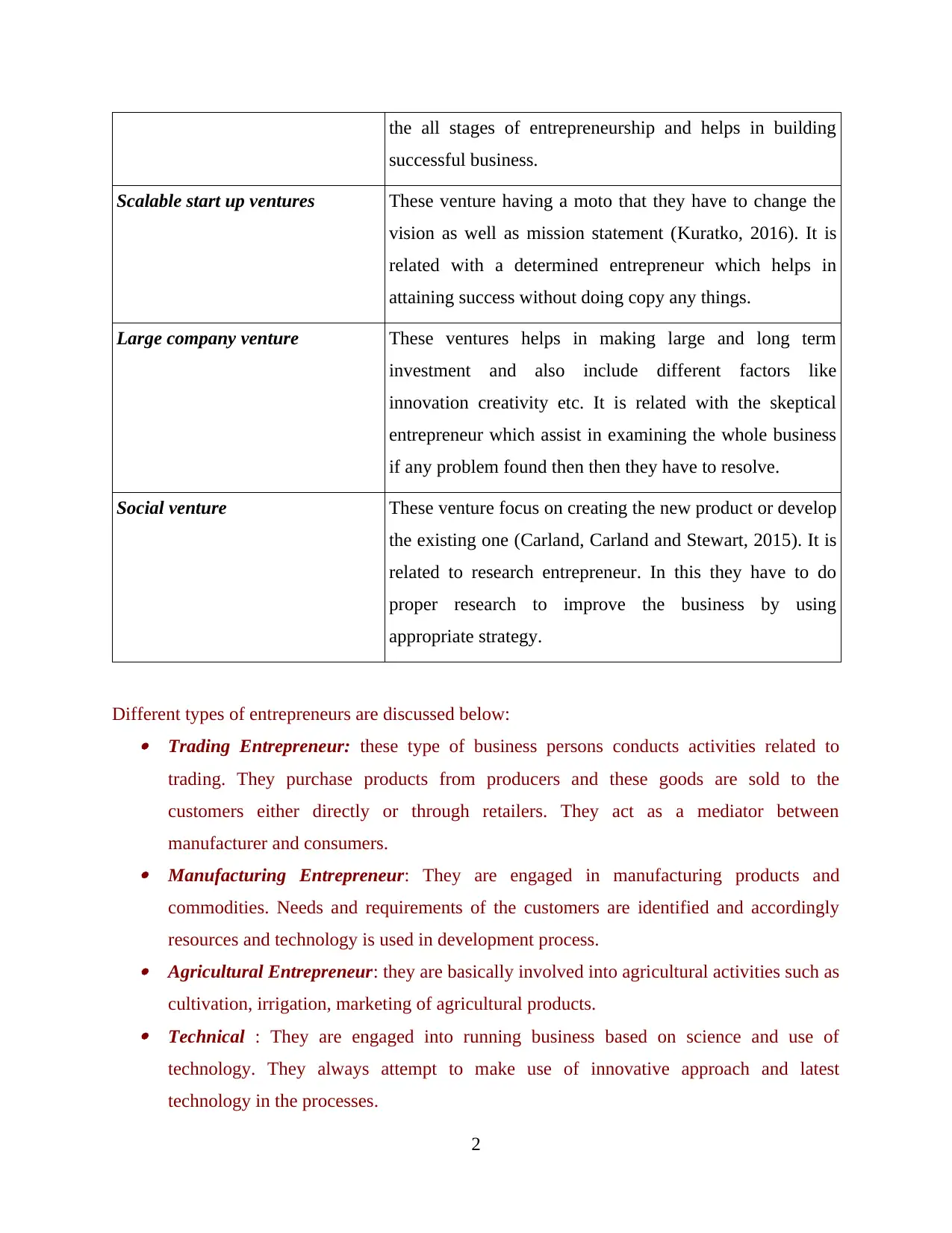
the all stages of entrepreneurship and helps in building
successful business.
Scalable start up ventures These venture having a moto that they have to change the
vision as well as mission statement (Kuratko, 2016). It is
related with a determined entrepreneur which helps in
attaining success without doing copy any things.
Large company venture These ventures helps in making large and long term
investment and also include different factors like
innovation creativity etc. It is related with the skeptical
entrepreneur which assist in examining the whole business
if any problem found then then they have to resolve.
Social venture These venture focus on creating the new product or develop
the existing one (Carland, Carland and Stewart, 2015). It is
related to research entrepreneur. In this they have to do
proper research to improve the business by using
appropriate strategy.
Different types of entrepreneurs are discussed below: Trading Entrepreneur: these type of business persons conducts activities related to
trading. They purchase products from producers and these goods are sold to the
customers either directly or through retailers. They act as a mediator between
manufacturer and consumers. Manufacturing Entrepreneur: They are engaged in manufacturing products and
commodities. Needs and requirements of the customers are identified and accordingly
resources and technology is used in development process. Agricultural Entrepreneur: they are basically involved into agricultural activities such as
cultivation, irrigation, marketing of agricultural products. Technical : They are engaged into running business based on science and use of
technology. They always attempt to make use of innovative approach and latest
technology in the processes.
2
successful business.
Scalable start up ventures These venture having a moto that they have to change the
vision as well as mission statement (Kuratko, 2016). It is
related with a determined entrepreneur which helps in
attaining success without doing copy any things.
Large company venture These ventures helps in making large and long term
investment and also include different factors like
innovation creativity etc. It is related with the skeptical
entrepreneur which assist in examining the whole business
if any problem found then then they have to resolve.
Social venture These venture focus on creating the new product or develop
the existing one (Carland, Carland and Stewart, 2015). It is
related to research entrepreneur. In this they have to do
proper research to improve the business by using
appropriate strategy.
Different types of entrepreneurs are discussed below: Trading Entrepreneur: these type of business persons conducts activities related to
trading. They purchase products from producers and these goods are sold to the
customers either directly or through retailers. They act as a mediator between
manufacturer and consumers. Manufacturing Entrepreneur: They are engaged in manufacturing products and
commodities. Needs and requirements of the customers are identified and accordingly
resources and technology is used in development process. Agricultural Entrepreneur: they are basically involved into agricultural activities such as
cultivation, irrigation, marketing of agricultural products. Technical : They are engaged into running business based on science and use of
technology. They always attempt to make use of innovative approach and latest
technology in the processes.
2
⊘ This is a preview!⊘
Do you want full access?
Subscribe today to unlock all pages.

Trusted by 1+ million students worldwide
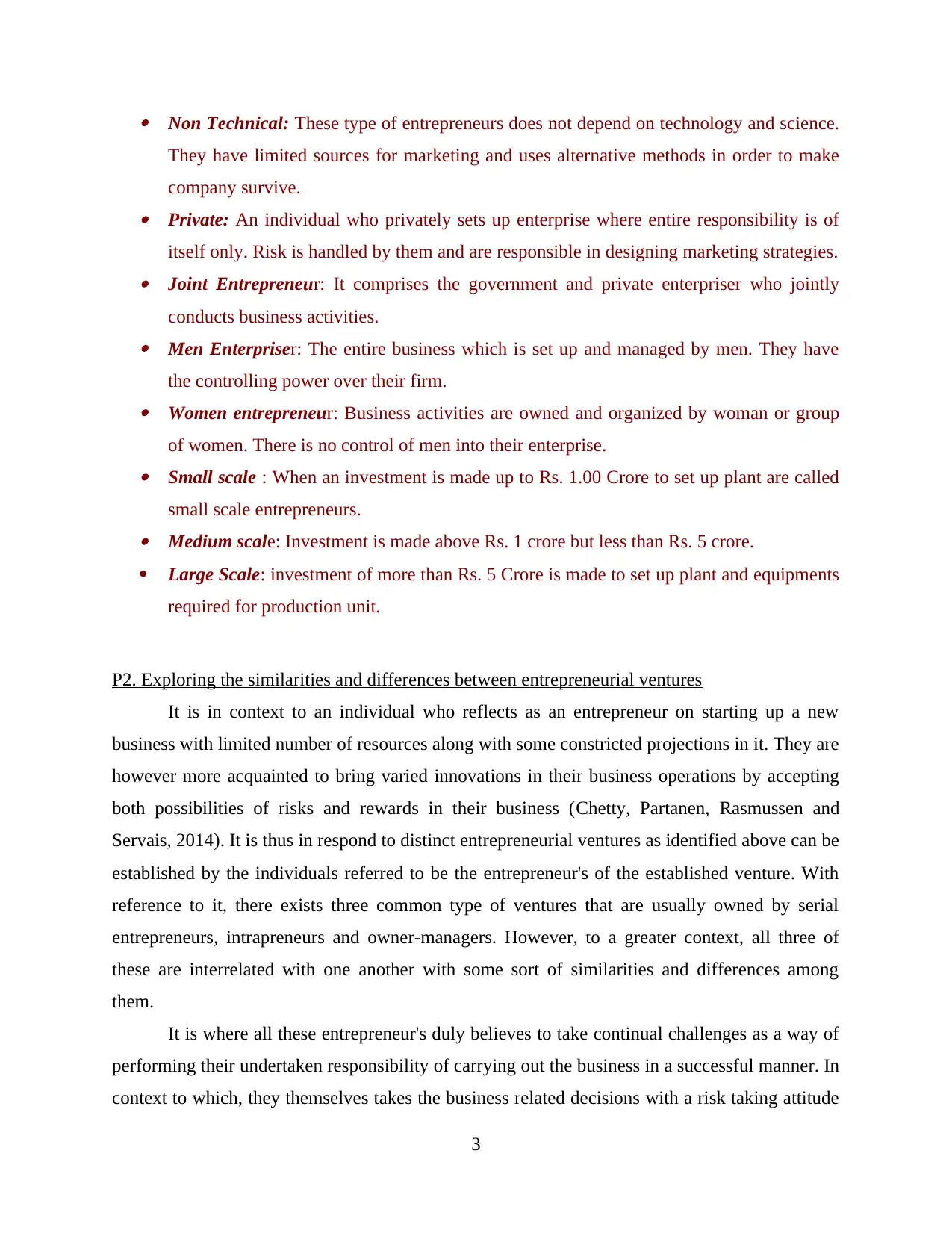
Non Technical: These type of entrepreneurs does not depend on technology and science.
They have limited sources for marketing and uses alternative methods in order to make
company survive. Private: An individual who privately sets up enterprise where entire responsibility is of
itself only. Risk is handled by them and are responsible in designing marketing strategies. Joint Entrepreneur: It comprises the government and private enterpriser who jointly
conducts business activities. Men Enterpriser: The entire business which is set up and managed by men. They have
the controlling power over their firm. Women entrepreneur: Business activities are owned and organized by woman or group
of women. There is no control of men into their enterprise. Small scale : When an investment is made up to Rs. 1.00 Crore to set up plant are called
small scale entrepreneurs. Medium scale: Investment is made above Rs. 1 crore but less than Rs. 5 crore.
Large Scale: investment of more than Rs. 5 Crore is made to set up plant and equipments
required for production unit.
P2. Exploring the similarities and differences between entrepreneurial ventures
It is in context to an individual who reflects as an entrepreneur on starting up a new
business with limited number of resources along with some constricted projections in it. They are
however more acquainted to bring varied innovations in their business operations by accepting
both possibilities of risks and rewards in their business (Chetty, Partanen, Rasmussen and
Servais, 2014). It is thus in respond to distinct entrepreneurial ventures as identified above can be
established by the individuals referred to be the entrepreneur's of the established venture. With
reference to it, there exists three common type of ventures that are usually owned by serial
entrepreneurs, intrapreneurs and owner-managers. However, to a greater context, all three of
these are interrelated with one another with some sort of similarities and differences among
them.
It is where all these entrepreneur's duly believes to take continual challenges as a way of
performing their undertaken responsibility of carrying out the business in a successful manner. In
context to which, they themselves takes the business related decisions with a risk taking attitude
3
They have limited sources for marketing and uses alternative methods in order to make
company survive. Private: An individual who privately sets up enterprise where entire responsibility is of
itself only. Risk is handled by them and are responsible in designing marketing strategies. Joint Entrepreneur: It comprises the government and private enterpriser who jointly
conducts business activities. Men Enterpriser: The entire business which is set up and managed by men. They have
the controlling power over their firm. Women entrepreneur: Business activities are owned and organized by woman or group
of women. There is no control of men into their enterprise. Small scale : When an investment is made up to Rs. 1.00 Crore to set up plant are called
small scale entrepreneurs. Medium scale: Investment is made above Rs. 1 crore but less than Rs. 5 crore.
Large Scale: investment of more than Rs. 5 Crore is made to set up plant and equipments
required for production unit.
P2. Exploring the similarities and differences between entrepreneurial ventures
It is in context to an individual who reflects as an entrepreneur on starting up a new
business with limited number of resources along with some constricted projections in it. They are
however more acquainted to bring varied innovations in their business operations by accepting
both possibilities of risks and rewards in their business (Chetty, Partanen, Rasmussen and
Servais, 2014). It is thus in respond to distinct entrepreneurial ventures as identified above can be
established by the individuals referred to be the entrepreneur's of the established venture. With
reference to it, there exists three common type of ventures that are usually owned by serial
entrepreneurs, intrapreneurs and owner-managers. However, to a greater context, all three of
these are interrelated with one another with some sort of similarities and differences among
them.
It is where all these entrepreneur's duly believes to take continual challenges as a way of
performing their undertaken responsibility of carrying out the business in a successful manner. In
context to which, they themselves takes the business related decisions with a risk taking attitude
3
Paraphrase This Document
Need a fresh take? Get an instant paraphrase of this document with our AI Paraphraser
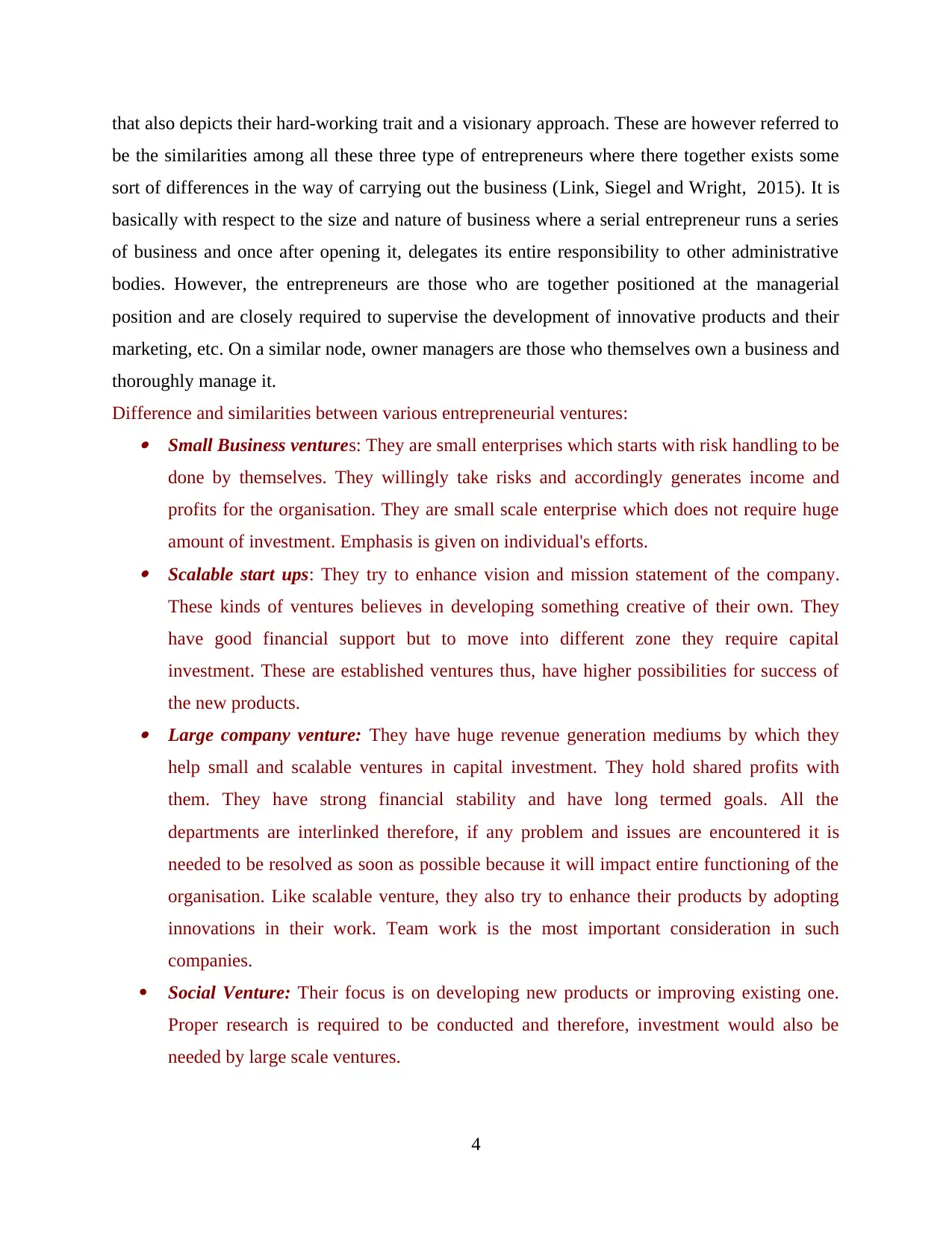
that also depicts their hard-working trait and a visionary approach. These are however referred to
be the similarities among all these three type of entrepreneurs where there together exists some
sort of differences in the way of carrying out the business (Link, Siegel and Wright, 2015). It is
basically with respect to the size and nature of business where a serial entrepreneur runs a series
of business and once after opening it, delegates its entire responsibility to other administrative
bodies. However, the entrepreneurs are those who are together positioned at the managerial
position and are closely required to supervise the development of innovative products and their
marketing, etc. On a similar node, owner managers are those who themselves own a business and
thoroughly manage it.
Difference and similarities between various entrepreneurial ventures: Small Business ventures: They are small enterprises which starts with risk handling to be
done by themselves. They willingly take risks and accordingly generates income and
profits for the organisation. They are small scale enterprise which does not require huge
amount of investment. Emphasis is given on individual's efforts. Scalable start ups: They try to enhance vision and mission statement of the company.
These kinds of ventures believes in developing something creative of their own. They
have good financial support but to move into different zone they require capital
investment. These are established ventures thus, have higher possibilities for success of
the new products. Large company venture: They have huge revenue generation mediums by which they
help small and scalable ventures in capital investment. They hold shared profits with
them. They have strong financial stability and have long termed goals. All the
departments are interlinked therefore, if any problem and issues are encountered it is
needed to be resolved as soon as possible because it will impact entire functioning of the
organisation. Like scalable venture, they also try to enhance their products by adopting
innovations in their work. Team work is the most important consideration in such
companies.
Social Venture: Their focus is on developing new products or improving existing one.
Proper research is required to be conducted and therefore, investment would also be
needed by large scale ventures.
4
be the similarities among all these three type of entrepreneurs where there together exists some
sort of differences in the way of carrying out the business (Link, Siegel and Wright, 2015). It is
basically with respect to the size and nature of business where a serial entrepreneur runs a series
of business and once after opening it, delegates its entire responsibility to other administrative
bodies. However, the entrepreneurs are those who are together positioned at the managerial
position and are closely required to supervise the development of innovative products and their
marketing, etc. On a similar node, owner managers are those who themselves own a business and
thoroughly manage it.
Difference and similarities between various entrepreneurial ventures: Small Business ventures: They are small enterprises which starts with risk handling to be
done by themselves. They willingly take risks and accordingly generates income and
profits for the organisation. They are small scale enterprise which does not require huge
amount of investment. Emphasis is given on individual's efforts. Scalable start ups: They try to enhance vision and mission statement of the company.
These kinds of ventures believes in developing something creative of their own. They
have good financial support but to move into different zone they require capital
investment. These are established ventures thus, have higher possibilities for success of
the new products. Large company venture: They have huge revenue generation mediums by which they
help small and scalable ventures in capital investment. They hold shared profits with
them. They have strong financial stability and have long termed goals. All the
departments are interlinked therefore, if any problem and issues are encountered it is
needed to be resolved as soon as possible because it will impact entire functioning of the
organisation. Like scalable venture, they also try to enhance their products by adopting
innovations in their work. Team work is the most important consideration in such
companies.
Social Venture: Their focus is on developing new products or improving existing one.
Proper research is required to be conducted and therefore, investment would also be
needed by large scale ventures.
4
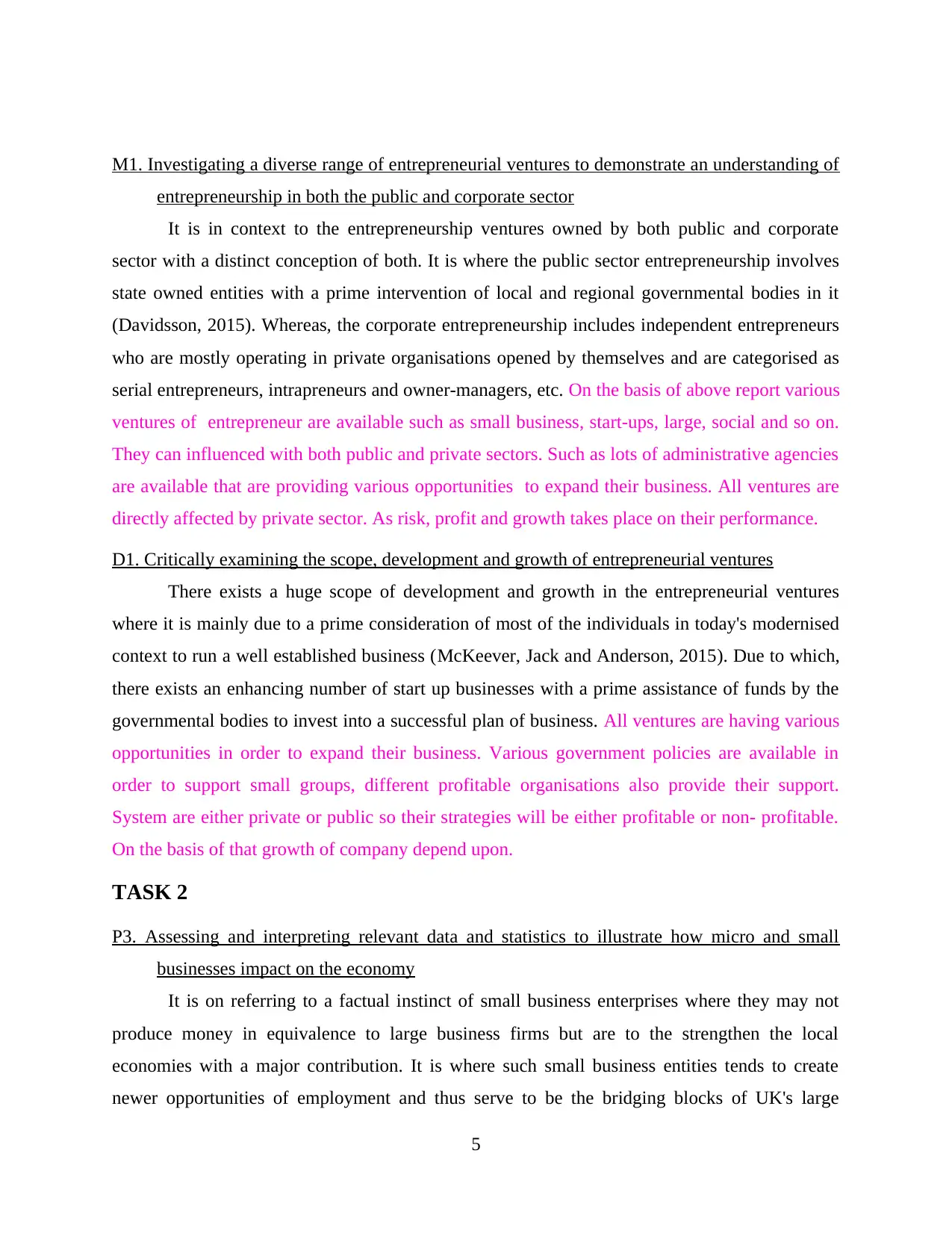
M1. Investigating a diverse range of entrepreneurial ventures to demonstrate an understanding of
entrepreneurship in both the public and corporate sector
It is in context to the entrepreneurship ventures owned by both public and corporate
sector with a distinct conception of both. It is where the public sector entrepreneurship involves
state owned entities with a prime intervention of local and regional governmental bodies in it
(Davidsson, 2015). Whereas, the corporate entrepreneurship includes independent entrepreneurs
who are mostly operating in private organisations opened by themselves and are categorised as
serial entrepreneurs, intrapreneurs and owner-managers, etc. On the basis of above report various
ventures of entrepreneur are available such as small business, start-ups, large, social and so on.
They can influenced with both public and private sectors. Such as lots of administrative agencies
are available that are providing various opportunities to expand their business. All ventures are
directly affected by private sector. As risk, profit and growth takes place on their performance.
D1. Critically examining the scope, development and growth of entrepreneurial ventures
There exists a huge scope of development and growth in the entrepreneurial ventures
where it is mainly due to a prime consideration of most of the individuals in today's modernised
context to run a well established business (McKeever, Jack and Anderson, 2015). Due to which,
there exists an enhancing number of start up businesses with a prime assistance of funds by the
governmental bodies to invest into a successful plan of business. All ventures are having various
opportunities in order to expand their business. Various government policies are available in
order to support small groups, different profitable organisations also provide their support.
System are either private or public so their strategies will be either profitable or non- profitable.
On the basis of that growth of company depend upon.
TASK 2
P3. Assessing and interpreting relevant data and statistics to illustrate how micro and small
businesses impact on the economy
It is on referring to a factual instinct of small business enterprises where they may not
produce money in equivalence to large business firms but are to the strengthen the local
economies with a major contribution. It is where such small business entities tends to create
newer opportunities of employment and thus serve to be the bridging blocks of UK's large
5
entrepreneurship in both the public and corporate sector
It is in context to the entrepreneurship ventures owned by both public and corporate
sector with a distinct conception of both. It is where the public sector entrepreneurship involves
state owned entities with a prime intervention of local and regional governmental bodies in it
(Davidsson, 2015). Whereas, the corporate entrepreneurship includes independent entrepreneurs
who are mostly operating in private organisations opened by themselves and are categorised as
serial entrepreneurs, intrapreneurs and owner-managers, etc. On the basis of above report various
ventures of entrepreneur are available such as small business, start-ups, large, social and so on.
They can influenced with both public and private sectors. Such as lots of administrative agencies
are available that are providing various opportunities to expand their business. All ventures are
directly affected by private sector. As risk, profit and growth takes place on their performance.
D1. Critically examining the scope, development and growth of entrepreneurial ventures
There exists a huge scope of development and growth in the entrepreneurial ventures
where it is mainly due to a prime consideration of most of the individuals in today's modernised
context to run a well established business (McKeever, Jack and Anderson, 2015). Due to which,
there exists an enhancing number of start up businesses with a prime assistance of funds by the
governmental bodies to invest into a successful plan of business. All ventures are having various
opportunities in order to expand their business. Various government policies are available in
order to support small groups, different profitable organisations also provide their support.
System are either private or public so their strategies will be either profitable or non- profitable.
On the basis of that growth of company depend upon.
TASK 2
P3. Assessing and interpreting relevant data and statistics to illustrate how micro and small
businesses impact on the economy
It is on referring to a factual instinct of small business enterprises where they may not
produce money in equivalence to large business firms but are to the strengthen the local
economies with a major contribution. It is where such small business entities tends to create
newer opportunities of employment and thus serve to be the bridging blocks of UK's large
5
⊘ This is a preview!⊘
Do you want full access?
Subscribe today to unlock all pages.

Trusted by 1+ million students worldwide
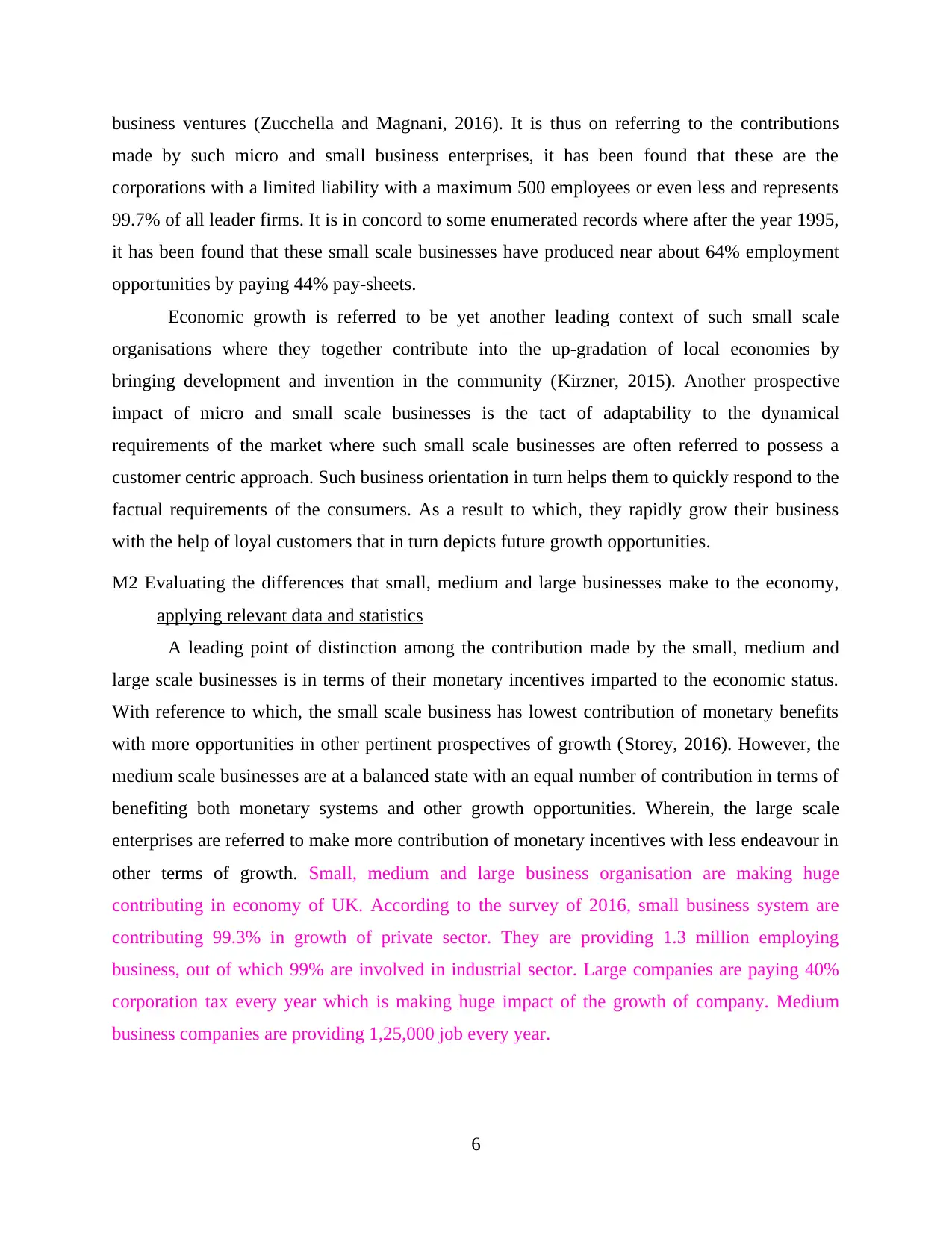
business ventures (Zucchella and Magnani, 2016). It is thus on referring to the contributions
made by such micro and small business enterprises, it has been found that these are the
corporations with a limited liability with a maximum 500 employees or even less and represents
99.7% of all leader firms. It is in concord to some enumerated records where after the year 1995,
it has been found that these small scale businesses have produced near about 64% employment
opportunities by paying 44% pay-sheets.
Economic growth is referred to be yet another leading context of such small scale
organisations where they together contribute into the up-gradation of local economies by
bringing development and invention in the community (Kirzner, 2015). Another prospective
impact of micro and small scale businesses is the tact of adaptability to the dynamical
requirements of the market where such small scale businesses are often referred to possess a
customer centric approach. Such business orientation in turn helps them to quickly respond to the
factual requirements of the consumers. As a result to which, they rapidly grow their business
with the help of loyal customers that in turn depicts future growth opportunities.
M2 Evaluating the differences that small, medium and large businesses make to the economy,
applying relevant data and statistics
A leading point of distinction among the contribution made by the small, medium and
large scale businesses is in terms of their monetary incentives imparted to the economic status.
With reference to which, the small scale business has lowest contribution of monetary benefits
with more opportunities in other pertinent prospectives of growth (Storey, 2016). However, the
medium scale businesses are at a balanced state with an equal number of contribution in terms of
benefiting both monetary systems and other growth opportunities. Wherein, the large scale
enterprises are referred to make more contribution of monetary incentives with less endeavour in
other terms of growth. Small, medium and large business organisation are making huge
contributing in economy of UK. According to the survey of 2016, small business system are
contributing 99.3% in growth of private sector. They are providing 1.3 million employing
business, out of which 99% are involved in industrial sector. Large companies are paying 40%
corporation tax every year which is making huge impact of the growth of company. Medium
business companies are providing 1,25,000 job every year.
6
made by such micro and small business enterprises, it has been found that these are the
corporations with a limited liability with a maximum 500 employees or even less and represents
99.7% of all leader firms. It is in concord to some enumerated records where after the year 1995,
it has been found that these small scale businesses have produced near about 64% employment
opportunities by paying 44% pay-sheets.
Economic growth is referred to be yet another leading context of such small scale
organisations where they together contribute into the up-gradation of local economies by
bringing development and invention in the community (Kirzner, 2015). Another prospective
impact of micro and small scale businesses is the tact of adaptability to the dynamical
requirements of the market where such small scale businesses are often referred to possess a
customer centric approach. Such business orientation in turn helps them to quickly respond to the
factual requirements of the consumers. As a result to which, they rapidly grow their business
with the help of loyal customers that in turn depicts future growth opportunities.
M2 Evaluating the differences that small, medium and large businesses make to the economy,
applying relevant data and statistics
A leading point of distinction among the contribution made by the small, medium and
large scale businesses is in terms of their monetary incentives imparted to the economic status.
With reference to which, the small scale business has lowest contribution of monetary benefits
with more opportunities in other pertinent prospectives of growth (Storey, 2016). However, the
medium scale businesses are at a balanced state with an equal number of contribution in terms of
benefiting both monetary systems and other growth opportunities. Wherein, the large scale
enterprises are referred to make more contribution of monetary incentives with less endeavour in
other terms of growth. Small, medium and large business organisation are making huge
contributing in economy of UK. According to the survey of 2016, small business system are
contributing 99.3% in growth of private sector. They are providing 1.3 million employing
business, out of which 99% are involved in industrial sector. Large companies are paying 40%
corporation tax every year which is making huge impact of the growth of company. Medium
business companies are providing 1,25,000 job every year.
6
Paraphrase This Document
Need a fresh take? Get an instant paraphrase of this document with our AI Paraphraser
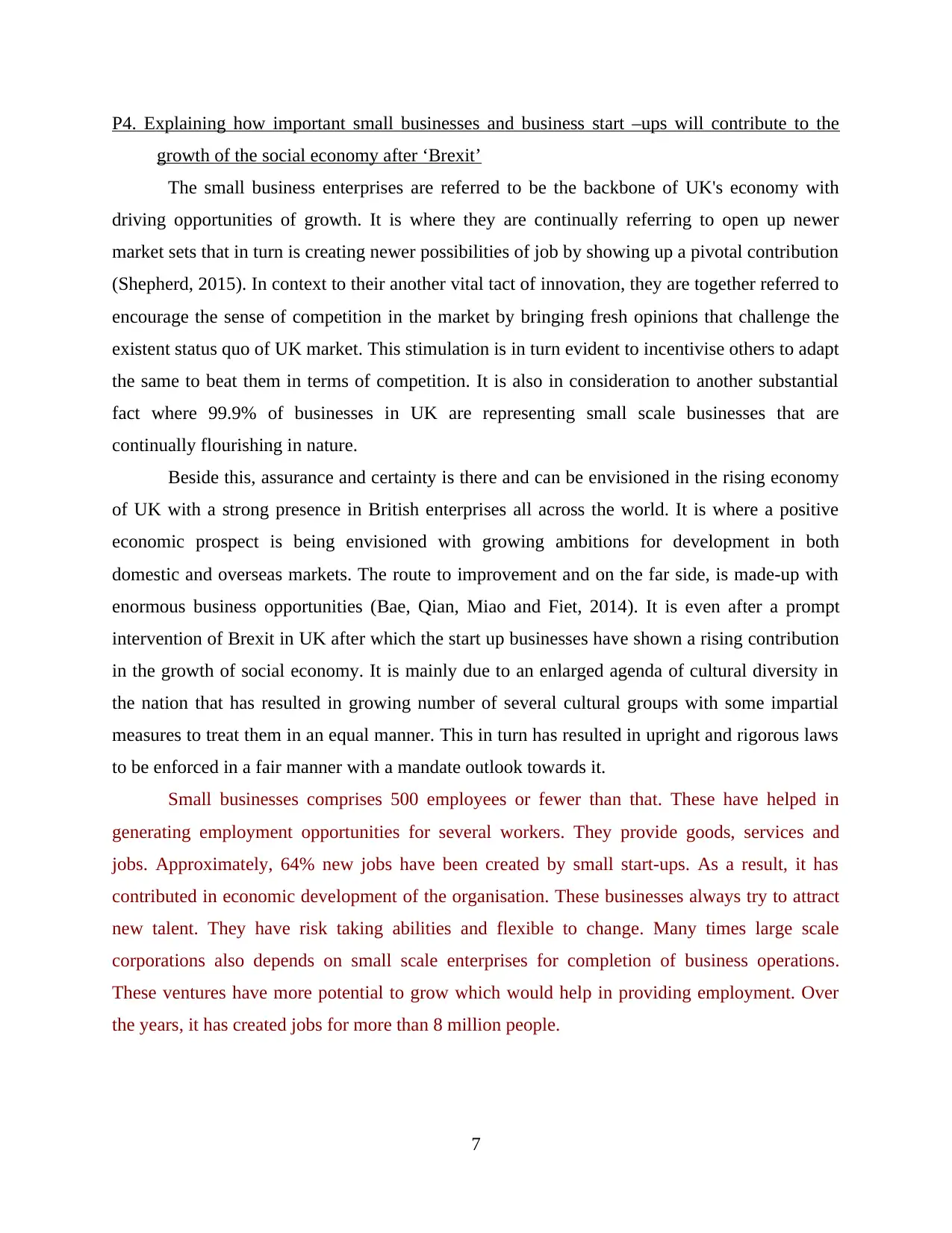
P4. Explaining how important small businesses and business start –ups will contribute to the
growth of the social economy after ‘Brexit’
The small business enterprises are referred to be the backbone of UK's economy with
driving opportunities of growth. It is where they are continually referring to open up newer
market sets that in turn is creating newer possibilities of job by showing up a pivotal contribution
(Shepherd, 2015). In context to their another vital tact of innovation, they are together referred to
encourage the sense of competition in the market by bringing fresh opinions that challenge the
existent status quo of UK market. This stimulation is in turn evident to incentivise others to adapt
the same to beat them in terms of competition. It is also in consideration to another substantial
fact where 99.9% of businesses in UK are representing small scale businesses that are
continually flourishing in nature.
Beside this, assurance and certainty is there and can be envisioned in the rising economy
of UK with a strong presence in British enterprises all across the world. It is where a positive
economic prospect is being envisioned with growing ambitions for development in both
domestic and overseas markets. The route to improvement and on the far side, is made-up with
enormous business opportunities (Bae, Qian, Miao and Fiet, 2014). It is even after a prompt
intervention of Brexit in UK after which the start up businesses have shown a rising contribution
in the growth of social economy. It is mainly due to an enlarged agenda of cultural diversity in
the nation that has resulted in growing number of several cultural groups with some impartial
measures to treat them in an equal manner. This in turn has resulted in upright and rigorous laws
to be enforced in a fair manner with a mandate outlook towards it.
Small businesses comprises 500 employees or fewer than that. These have helped in
generating employment opportunities for several workers. They provide goods, services and
jobs. Approximately, 64% new jobs have been created by small start-ups. As a result, it has
contributed in economic development of the organisation. These businesses always try to attract
new talent. They have risk taking abilities and flexible to change. Many times large scale
corporations also depends on small scale enterprises for completion of business operations.
These ventures have more potential to grow which would help in providing employment. Over
the years, it has created jobs for more than 8 million people.
7
growth of the social economy after ‘Brexit’
The small business enterprises are referred to be the backbone of UK's economy with
driving opportunities of growth. It is where they are continually referring to open up newer
market sets that in turn is creating newer possibilities of job by showing up a pivotal contribution
(Shepherd, 2015). In context to their another vital tact of innovation, they are together referred to
encourage the sense of competition in the market by bringing fresh opinions that challenge the
existent status quo of UK market. This stimulation is in turn evident to incentivise others to adapt
the same to beat them in terms of competition. It is also in consideration to another substantial
fact where 99.9% of businesses in UK are representing small scale businesses that are
continually flourishing in nature.
Beside this, assurance and certainty is there and can be envisioned in the rising economy
of UK with a strong presence in British enterprises all across the world. It is where a positive
economic prospect is being envisioned with growing ambitions for development in both
domestic and overseas markets. The route to improvement and on the far side, is made-up with
enormous business opportunities (Bae, Qian, Miao and Fiet, 2014). It is even after a prompt
intervention of Brexit in UK after which the start up businesses have shown a rising contribution
in the growth of social economy. It is mainly due to an enlarged agenda of cultural diversity in
the nation that has resulted in growing number of several cultural groups with some impartial
measures to treat them in an equal manner. This in turn has resulted in upright and rigorous laws
to be enforced in a fair manner with a mandate outlook towards it.
Small businesses comprises 500 employees or fewer than that. These have helped in
generating employment opportunities for several workers. They provide goods, services and
jobs. Approximately, 64% new jobs have been created by small start-ups. As a result, it has
contributed in economic development of the organisation. These businesses always try to attract
new talent. They have risk taking abilities and flexible to change. Many times large scale
corporations also depends on small scale enterprises for completion of business operations.
These ventures have more potential to grow which would help in providing employment. Over
the years, it has created jobs for more than 8 million people.
7
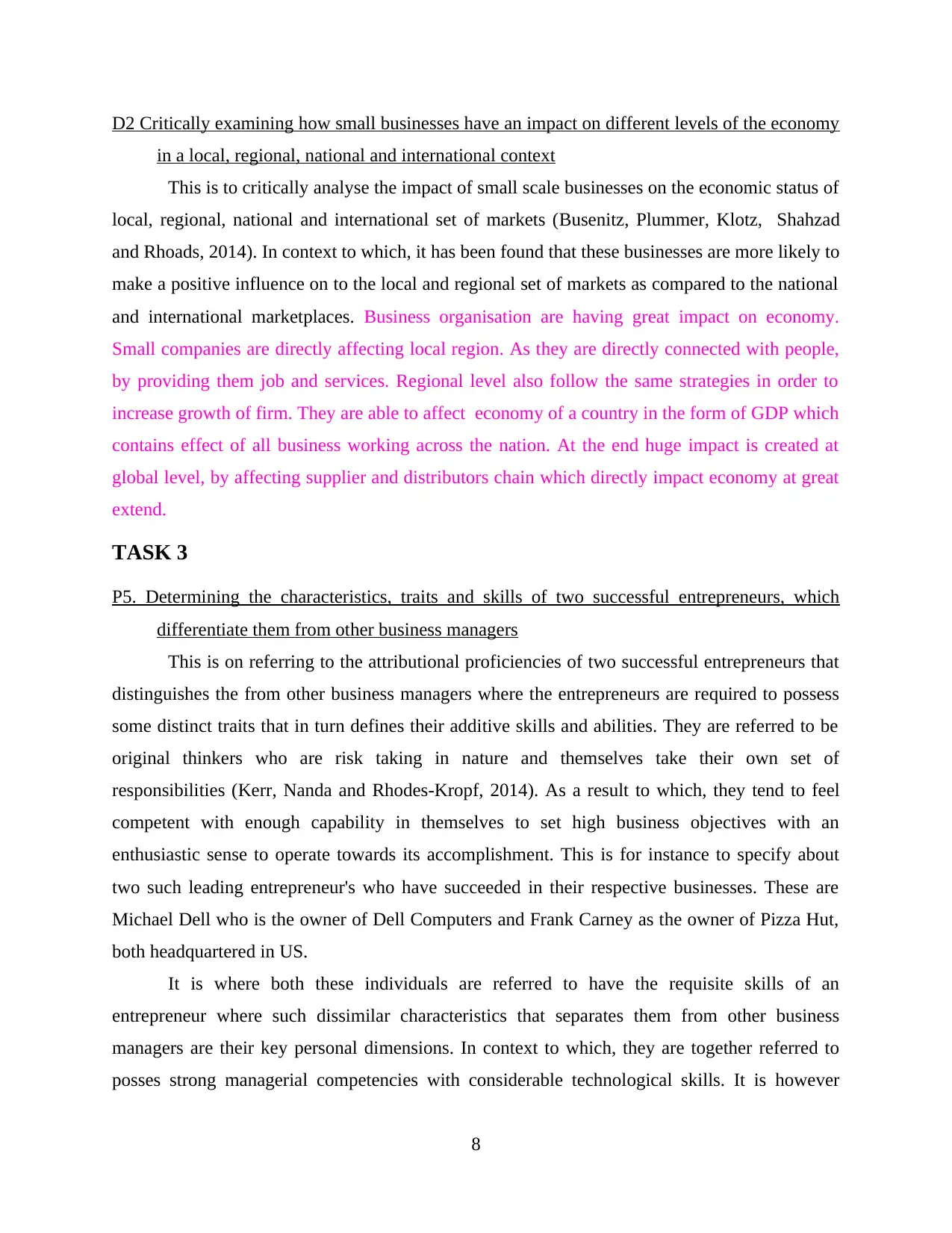
D2 Critically examining how small businesses have an impact on different levels of the economy
in a local, regional, national and international context
This is to critically analyse the impact of small scale businesses on the economic status of
local, regional, national and international set of markets (Busenitz, Plummer, Klotz, Shahzad
and Rhoads, 2014). In context to which, it has been found that these businesses are more likely to
make a positive influence on to the local and regional set of markets as compared to the national
and international marketplaces. Business organisation are having great impact on economy.
Small companies are directly affecting local region. As they are directly connected with people,
by providing them job and services. Regional level also follow the same strategies in order to
increase growth of firm. They are able to affect economy of a country in the form of GDP which
contains effect of all business working across the nation. At the end huge impact is created at
global level, by affecting supplier and distributors chain which directly impact economy at great
extend.
TASK 3
P5. Determining the characteristics, traits and skills of two successful entrepreneurs, which
differentiate them from other business managers
This is on referring to the attributional proficiencies of two successful entrepreneurs that
distinguishes the from other business managers where the entrepreneurs are required to possess
some distinct traits that in turn defines their additive skills and abilities. They are referred to be
original thinkers who are risk taking in nature and themselves take their own set of
responsibilities (Kerr, Nanda and Rhodes-Kropf, 2014). As a result to which, they tend to feel
competent with enough capability in themselves to set high business objectives with an
enthusiastic sense to operate towards its accomplishment. This is for instance to specify about
two such leading entrepreneur's who have succeeded in their respective businesses. These are
Michael Dell who is the owner of Dell Computers and Frank Carney as the owner of Pizza Hut,
both headquartered in US.
It is where both these individuals are referred to have the requisite skills of an
entrepreneur where such dissimilar characteristics that separates them from other business
managers are their key personal dimensions. In context to which, they are together referred to
posses strong managerial competencies with considerable technological skills. It is however
8
in a local, regional, national and international context
This is to critically analyse the impact of small scale businesses on the economic status of
local, regional, national and international set of markets (Busenitz, Plummer, Klotz, Shahzad
and Rhoads, 2014). In context to which, it has been found that these businesses are more likely to
make a positive influence on to the local and regional set of markets as compared to the national
and international marketplaces. Business organisation are having great impact on economy.
Small companies are directly affecting local region. As they are directly connected with people,
by providing them job and services. Regional level also follow the same strategies in order to
increase growth of firm. They are able to affect economy of a country in the form of GDP which
contains effect of all business working across the nation. At the end huge impact is created at
global level, by affecting supplier and distributors chain which directly impact economy at great
extend.
TASK 3
P5. Determining the characteristics, traits and skills of two successful entrepreneurs, which
differentiate them from other business managers
This is on referring to the attributional proficiencies of two successful entrepreneurs that
distinguishes the from other business managers where the entrepreneurs are required to possess
some distinct traits that in turn defines their additive skills and abilities. They are referred to be
original thinkers who are risk taking in nature and themselves take their own set of
responsibilities (Kerr, Nanda and Rhodes-Kropf, 2014). As a result to which, they tend to feel
competent with enough capability in themselves to set high business objectives with an
enthusiastic sense to operate towards its accomplishment. This is for instance to specify about
two such leading entrepreneur's who have succeeded in their respective businesses. These are
Michael Dell who is the owner of Dell Computers and Frank Carney as the owner of Pizza Hut,
both headquartered in US.
It is where both these individuals are referred to have the requisite skills of an
entrepreneur where such dissimilar characteristics that separates them from other business
managers are their key personal dimensions. In context to which, they are together referred to
posses strong managerial competencies with considerable technological skills. It is however
8
⊘ This is a preview!⊘
Do you want full access?
Subscribe today to unlock all pages.

Trusted by 1+ million students worldwide
1 out of 21
Related Documents
Your All-in-One AI-Powered Toolkit for Academic Success.
+13062052269
info@desklib.com
Available 24*7 on WhatsApp / Email
![[object Object]](/_next/static/media/star-bottom.7253800d.svg)
Unlock your academic potential
Copyright © 2020–2025 A2Z Services. All Rights Reserved. Developed and managed by ZUCOL.


